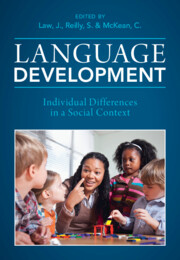Book contents
- Language Development
- Language Development
- Copyright page
- Contents
- Figures
- Tables
- Contributors
- A Tribute to Our Friend, Colleague and Fellow Editor, Professor James Law
- Introduction
- Part One Factors Influencing Language Development
- Part Two Continuity and Change
- Part Three Impact, Intervention and Equity
- 15 Communication, Participation and Cohort Studies
- 16 Capturing the Voice of Parents and Children
- 17 Oral Language Skills as a Foundation for Learning to Learn
- 18 The Economic Impact of Low Language Ability in Childhood
- 19 A Review of Interventions to Promote Language Development in Early Childhood
- 20 Interventions to Promote Language Development in Typical and Atypical Populations
- 21 The Effect of Kindergarten Instructional Policies on Reading and Math Achievement Gaps
- 22 Educational Interventions Targeting Language Development
- 23 Equity and Access to Services for Children with Language Difficulties
- Index
- References
23 - Equity and Access to Services for Children with Language Difficulties
from Part Three - Impact, Intervention and Equity
Published online by Cambridge University Press: 11 August 2022
- Language Development
- Language Development
- Copyright page
- Contents
- Figures
- Tables
- Contributors
- A Tribute to Our Friend, Colleague and Fellow Editor, Professor James Law
- Introduction
- Part One Factors Influencing Language Development
- Part Two Continuity and Change
- Part Three Impact, Intervention and Equity
- 15 Communication, Participation and Cohort Studies
- 16 Capturing the Voice of Parents and Children
- 17 Oral Language Skills as a Foundation for Learning to Learn
- 18 The Economic Impact of Low Language Ability in Childhood
- 19 A Review of Interventions to Promote Language Development in Early Childhood
- 20 Interventions to Promote Language Development in Typical and Atypical Populations
- 21 The Effect of Kindergarten Instructional Policies on Reading and Math Achievement Gaps
- 22 Educational Interventions Targeting Language Development
- 23 Equity and Access to Services for Children with Language Difficulties
- Index
- References
Summary
Care injustice, sometimes termed the ‘postcode lottery’ arises when individuals cannot access services simply because of where they reside. The distribution and access to health and education services for children with language difficulties is explored in this chapter. There is a body of literature demonstrating that service availability and accessibility can differ markedly between metropolitan and rural settings. Here, we draw on available evidence to discuss the relationship between health inequities and inequalities, proposing a place-based approach as a potential solution, which encourages the location and distribution of services based on community need. This chapter also addresses the way in which many services have been historically developed, that is, along the traditional ‘clinical’ model rather than a model which considers and reviews the needs of a community from a population health perspective and likely needs of the child population. We conclude by highlighting some key steps that need to be taken to ensure the design and delivery of services to meet the future needs of the population, and outline some of the challenges in adopting this approach.
- Type
- Chapter
- Information
- Language DevelopmentIndividual Differences in a Social Context, pp. 539 - 560Publisher: Cambridge University PressPrint publication year: 2022
References
- 1
- Cited by



